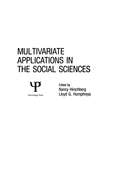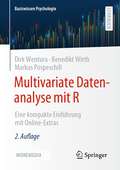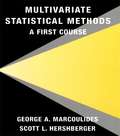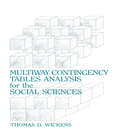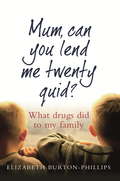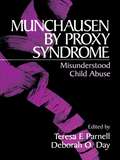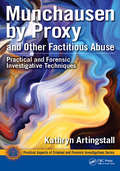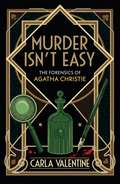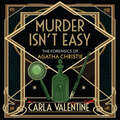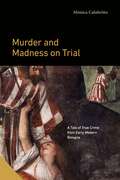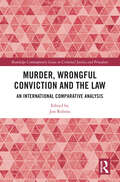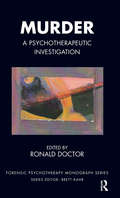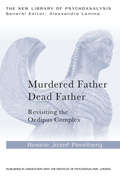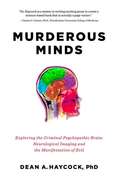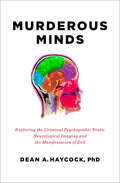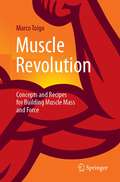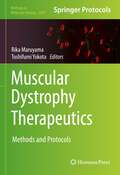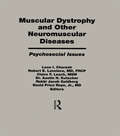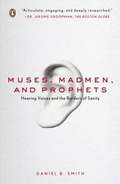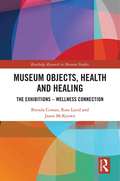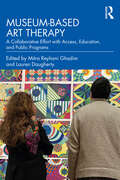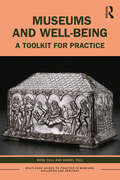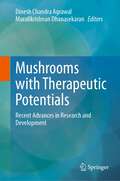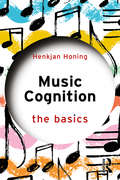- Table View
- List View
Multivariate Applications in the Social Sciences
by Nancy Hirschberg Lloyd G. HumphreysFirst published in 1982. Textbooks in multivariate methods proliferate, but there are few books concerned with their application. Experimental psychology and its associated method of statistical data analysis, analysis of variance, has tended to dominate psychological thinking even in such areas as social and clinical psychology, two areas that are particularly ill-suited to simple analysis-of-variance statistical models. The recent emphasis of clinical and social psychology on applied research relevant to social problems requires that more attention be paid to multivariate methods and appropriate research designs. this book illustrates and examines the multivariate approach alone, this does not imply that a multivariate approach combined with an experimental approach would not in the long run provide the best overall research design. The present collection of multivariate applications introduces some of the kinds of research problem that can be tackled by means of multivariate statistical analysis.
Multivariate Datenanalyse mit R: Eine kompakte Einführung mit Online-Extras (Basiswissen Psychologie)
by Dirk Wentura Markus Pospeschill Benedikt WirthWas sind Multivariate Verfahren? Wozu dienen sie, wie werden sie richtig eingesetzt? Das Buch liefert einen fundierten Überblick über diese wichtige Klasse von Verfahren, die in der Psychologie und den Sozialwissenschaften zunehmend an Bedeutung gewinnt. So werden einerseits die vielfältigen Möglichkeiten dieser Methoden aufgezeigt, aber auch auf Grenzen und Schwächen hingewiesen. Zahlreiche Beispiele und eine verständliche Sprache tragen zur Lebendigkeit dieser zu keinem Zeitpunkt langweiligen Einführung bei.
Multivariate Statistical Methods: A First Course
by George A. Marcoulides Scott L. HershbergerMultivariate statistics refer to an assortment of statistical methods that have been developed to handle situations in which multiple variables or measures are involved. Any analysis of more than two variables or measures can loosely be considered a multivariate statistical analysis. An introductory text for students learning multivariate statistical methods for the first time, this book keeps mathematical details to a minimum while conveying the basic principles. One of the principal strategies used throughout the book--in addition to the presentation of actual data analyses--is pointing out the analogy between a common univariate statistical technique and the corresponding multivariate method. Many computer examples--drawing on SAS software --are used as demonstrations. Throughout the book, the computer is used as an adjunct to the presentation of a multivariate statistical method in an empirically oriented approach. Basically, the model adopted in this book is to first present the theory of a multivariate statistical method along with the basic mathematical computations necessary for the analysis of data. Subsequently, a real world problem is discussed and an example data set is provided for analysis. Throughout the presentation and discussion of a method, many references are made to the computer, output are explained, and exercises and examples with real data are included.
Multiway Contingency Tables Analysis for the Social Sciences
by Thomas D. WickensThis book describes the principles and techniques needed to analyze data that form a multiway contingency table. Wickens discusses the description of association in such data using log-linear and log-multiplicative models and defines how the presence of association is tested using hypotheses of independence and quasi-independence. The application of the procedures to real data is then detailed. This volume does not presuppose prior experience or knowledge of statistics beyond basic courses in fundamentals of probability and statistical inference. It serves as an ideal reference for professionals or as a textbook for graduate or advanced undergraduate students involved in statistics in the social sciences.
Mum, Can You Lend Me Twenty Quid?: What drugs did to my family
by Elizabeth Burton-Phillips MBEi newspaper 'What We're Reading This Week' December 2017'Elizabeth's courage in speaking out is moving, and her ability to move others is impressive. This is a story that needs to be told, and needs to be heard.' - Theresa May, Prime Minister'Elizabeth [is] someone who had the courage to tell her family's story and to challenge attitudes. Elizabeth has already made a difference and I am sure that all those who read this book will be both challenged and inspired.' - Chief Constable Sara Thornton, National Police Chiefs' Council'I cannot praise this book highly enough . . . Born out of personal pain and tragedy, this story will lead you to the birth of DrugFAM . . . It is truly inspiring and wonderful what has been and continues to be achieved through this story.' - Sir Anthony Seldon, Vice-Chancellor of the University of Buckingham'I would urge all parents, teachers and pupils to read this heart-rending book.' - FT Magazine'A book that is moving and ultimately, inspiring.' - Waterstones Books QuarterlyElizabeth Burton Phillips was a teacher, an ordinary mother who had always tried to do the best for her children; she never imagined that her identical twin sons, who had been doing so well at school, would become involved in drugs. She was shocked when they were suspended from school for smoking cannabis; but this was just the start of a terrible descent into personal and family heartbreak. The painful journey ended in the way Elizabeth had always dreaded - a knock on the door in the middle of the night by the police. They gave her the devastating news that her son Nick had killed himself in despair at his heroin addiction. Since his death, Elizabeth has campaigned tirelessly to make parents aware of the pain and suffering caused to families by drug addiction; and her surviving twin, Simon, now drug-free, has contributed his own thoughts to this inspiring and gut-wrenching story that will shake every reader to the core.This new edition brings Elizabeth's story up to date, sharing the inspiring achievements of the author - awarded an MBE in the Queen's 2017 Honours List - and her charity DrugFAM, giving hope to families impacted by addiction.
Munchausen by Proxy Syndrome: Misunderstood Child Abuse
by Dr Teresa F. Parnell Deborah O. DayMunchausen by Proxy Syndrome (MBPS), a form of child abuse in which a primary carer - usually a mother - fabricates and//or induces illness in a child, is one of the least understood forms of child abuse and mental illness. Examining the current knowledge about the manifestations and consequences of this perplexing behaviour, this book assists all professionals working with chronically ill children in identifying and intervening with this bizarre and often deadly form of abuse. Drawing from their firsthand experience with the complexities of such cases, the editors and contributors address critical issues of not only identification and assessment but also long-term psychotherapy. Therapy with the mother//perpetrator has tra
Munchausen by Proxy and Other Factitious Abuse: Practical and Forensic Investigative Techniques (Practical Aspects of Criminal and Forensic Investigations #64)
by Kathryn ArtingstallThis book covers Munchausen and Munchausen by Proxy (MBP) though the terms have recently changed. The 2013 DSM-V—the update to the American Psychiatric Association's (APA) diagnostic and classification tool—has classified both Munchausen and MBP as "Factitious Systematic Abuse." While thought to have occurred primarily with children and their caregivers, recent research shows a more widespread problem: such medical abuse to spouses, the disabled, the elderly—even pets. Many involve repeat and long-term instances of hospital and medical fraud. This book covers the syndrome itself, interviewing and investigative aspects, victimology, as well indicators in the event of homicide and death.
Murder Isn't Easy: The Forensics of Agatha Christie
by Carla ValentineFascinating - PrimaAgatha Christie is one of our most beloved authors - a storyteller unparalleled in her clever plots and twisting tales. But Agatha was also a forensic expert; in each of her books she employs an expert weaving of human observation, ingenuity and genuine science of the era.In Murder Isn't Easy Carla Valentine illuminates all of Agatha's incredible knowledge, showing how she stayed at the cutting edge of forensics from ballistics to fingerprint analysis, as seen through much-loved characters such as Poirot and Miss Marple.From the glamour and grit of Agatha Christie's stories, to the real-life cases that inspired them, Murder Isn't Easy will immerse you in the forensics that influenced generations of writers and scientists alike.
Murder Isn't Easy: The Forensics of Agatha Christie
by Carla ValentineFascinating - PrimaEngaging and informative - GuardianAgatha Christie is one of our most beloved authors - a storyteller unparalleled in her clever plots and twisting tales. But Agatha was also a forensic expert; in each of her books she employs an expert weaving of human observation, ingenuity and genuine science of the era.In Murder Isn't Easy Carla Valentine illuminates all of Agatha's incredible knowledge, showing how she stayed at the cutting edge of forensics from ballistics to fingerprint analysis, as seen through much-loved characters such as Poirot and Miss Marple.From the glamour and grit of Agatha Christie's stories, to the real-life cases that inspired them, Murder Isn't Easy will immerse you in the forensics that influenced generations of writers and scientists alike.
Murder and Madness on Trial: A Tale of True Crime from Early Modern Bologna (Interactions in the Early Modern Age)
by Mònica CalabrittoOn October 24, 1588, Paolo Barbieri murdered his wife, Isabella Caccianemici, stabbing her to death with his sword. Later, Paolo would claim to have acted in a fit of madness—but was he criminally insane or merely pretending to be? In this riveting book, Mònica Calabritto addresses this controversy by reconstructing Paolo’s life, prosecution, and medical diagnoses.Skillfully combining archival documents unearthed throughout Italy, Calabritto brings to light the case of one person and his family as insanity ravaged their financial security, honor, and reputation. The very notion of insanity is as much on trial in Paolo’s case as the defendant himself. A case study in the diagnosis of insanity in the early modern era, Barbieri’s story reveals discrepancies between medical and legal definitions of a person’s mental state at the time of a crime. Murder and Madness on Trial bridges the micro-historical dimensions of Paolo’s murder case and the macro-historical perspectives on medical and legal evidence used to identify intermittent madness.A tragic and gripping tale, Murder and Madness on Trial allows readers to look “through a glass darkly” at early modern violence, madness, criminal justice, medical and legal expertise, and the construction and circulation of news. This erudite and engaging book will appeal to early modern historians and true crime fans alike.
Murder, Wrongful Conviction and the Law: An International Comparative Analysis (Routledge Contemporary Issues in Criminal Justice and Procedure)
by Jon RobinsThis collection brings together international experts to present a comparative analysis of wrongful conviction and criminal procedure. The volume takes an interdisciplinary approach with authors drawn from a broad range of backgrounds including law, psychology, forensics and journalism. All are experts in their field with direct experience of the investigation of wrongful conviction in their own countries. Focusing on the main areas of concern in their own jurisdiction, each author discusses common themes, including: the extent of the problem; the types of cases that feature in miscarriages of justice; the legal mechanism for the correction of a wrongful conviction; compensation for the wrongly convicted; public awareness and concern about the issue generally and in light of highprofile cases; and the extent to which wrongful conviction has driven criminal justice reform. The book will be essential reading for students, researchers and policy-makers interested in comparative law, criminology and psychology.
Murder: A Psychotherapeutic Investigation (The Forensic Psychotherapy Monograph Series)
by Ronald DoctorThis book, a sequel to the edited book Dangerous Patients: A Psychodynamic Approach to Risk Assessment and Management, places the emphasis on working in psychodynamic psychotherapy with patients who have killed to gain a greater understanding of their internal world and object relationships.
Murdered Father, Dead Father: Revisiting the Oedipus Complex (The New Library of Psychoanalysis)
by Rosine Jozef PerelbergMurdered Father, Dead Father: Revisiting the Oedipus Complex examines the progressive construction of the notion of paternal function and its central relevance in psychoanalysis. The distinction between the murdered (narcissistic) father and the dead father is seen as providing a paradigm for the understanding of different types of psychopathologies, as well as works of literature, anthropology and historical events. New concepts are introduced, such as "a father is being beaten", and a distinction between the descriptive après coup and the dynamic après coup that provides a model for a psychoanalytic understanding of temporality. The book includes a reflection on how the concepts of the death instinct and the negative, in their connection with that which is at the limits of representability, are an aid to an understanding of Auschwitz, a moment of rupture in European culture that the author characterizes as " the murder of the dead father". Perelberg’s book is an important clinical and intellectual marker, and will be required reading for psychoanalysts, psychotherapists, anthropologists, and historians, as well as students in all these disciplines.
Murderous Minds
by Dean A. HaycockIs there a biological basis for evil? From neurological imaging to behavioral studies, Dean Haycock's account of the groundbreaking research reveals what scientists are learning about the psychopaths living among us. How many times have you seen a murder on the news or on a TV show like CSI: Crime Scene Investigation, and said to yourself, "How could someone do something like that?" Today, neuroscientists are imaging, mapping, testing and dissecting the source of the worst behavior imaginable in the brains of the people who lack a conscience: psychopaths. Neuroscientist Dean Haycock examines the behavior of real life psychopaths and discusses how their actions can be explained in scientific terms, from research that literally looks inside their brains to understanding out psychopaths, without empathy but very goal-oriented, think and act the way they do. Some don&’t commit crimes at all, but rather make use of their skills in the boardroom. But what does this mean for lawyers, judges, psychiatrists, victims and readers--for anyone who has ever wondered how some people can be so bad. Could your nine-year-old be a psychopath? What about your co-worker? The ability to recognize psychopaths using the scientific method has vast implications for society, and yet is still loaded with consequences.
Murderous Minds: Neurological Imaging and the Manifestation of Evil
by Dean A. HaycockIs there a biological basis for evil? From neurological imaging to behavioral studies, Dean Haycock's account of the groundbreaking research reveals what scientists are learning about the psychopaths living among us. How many times have you seen a murder on the news or on a TV show like CSI: Crime Scene Investigation, and said to yourself, "How could someone do something like that?" Today, neuroscientists are imaging, mapping, testing and dissecting the source of the worst behavior imaginable in the brains of the people who lack a conscience: psychopaths. Neuroscientist Dean Haycock examines the behavior of real life psychopaths and discusses how their actions can be explained in scientific terms, from research that literally looks inside their brains to understanding how psychopaths, without empathy but very goal-oriented, think and act the way they do. Some don’t commit crimes at all, but rather make use of their skills in the boardroom. But what does this mean for lawyers, judges, psychiatrists, victims and readers--for anyone who has ever wondered how some people can be so bad. Could your nine-year-old be a psychopath? What about your co-worker? The ability to recognize psychopaths using the scientific method has vast implications for society, and yet is still loaded with consequences. 8 page color insert
Murderous Minds: Neurological Imaging and the Manifestation of Evil
by Dean HaycockHow many times have you seen a murder on the news or on a TV show like CSI: Crime Scene Investigation, and said to yourself, "How could someone do something like that?"Today, neuroscientists are imaging, mapping, testing and dissecting the source of the worst behavior imaginable in the brains of the people who lack a conscience: psychopaths. Neuroscientist Dean Haycock examines the behavior of real life psychopaths and discusses how their actions can be explained in scientific terms, from research that literally looks inside their brains to understanding how psychopaths, without empathy but very goal-oriented, think and act the way they do. Some don't commit crimes at all, but rather make use of their skills in the boardroom.But what does this mean for lawyers, judges, psychiatrists, victims, and readers--for anyone who has ever wondered how some people can be so bad. Could your nine-year-old be a psychopath? What about your co-worker? The ability to recognize psychopaths using the scientific method has vast implications for society, and yet is still loaded with consequences.
Muscle Revolution: Concepts and Recipes for Building Muscle Mass and Force
by Marco ToigoHow to Effectively and Efficiently Build Muscle Mass and Muscle ForceIn this informative as well as practical book based on the latest integrative muscle research, Marco Toigo, PhD, describes which factors are crucial to successfully build muscle mass and muscle force through resistance training. In addition, he presents the practical and science-based consequences for your training and nutritional behavior with a focus on protein intake. This work thus offers both a practical guide and a scientific explanation of the "why" and "how" of effective and efficient resistance training.This book is the English version of the very successful 2nd German edition of “MuskelRevolution“ (ISBN: 978-3-662-54764-9). The translation was done with the help of artificial intelligence. A subsequent human revision was done primarily in terms of content.
Muscular Dystrophy Therapeutics: Methods and Protocols (Methods in Molecular Biology #2587)
by Toshifumi Yokota Rika MaruyamaThis detailed book presents a comprehensive collection of state-of-the-art protocols on muscular dystrophy therapeutics, covering therapeutics using antisense oligonucleotides, gene replacement, genome editing, small molecules, stem cells, and antibodies. Written by leaders in the field, the volume explores techniques that are currently in use and are starting an exciting therapeutic revolution in muscular dystrophy. As a part of the highly successful Methods in Molecular Biology series, chapters include introductions to their respective topics, lists of the necessary materials and reagents, step-by-step and readily reproducible laboratory protocols, as well as tips on troubleshooting and avoiding known pitfalls. Authoritative and practical, Muscular Dystrophy Therapeutics: Methods and Protocols serves as an ideal resource to inspire readers and provide tips, strategies, and advice to develop new therapeutic technologies for this group of diseases.
Muscular Dystrophy and Other Neuromuscular Diseases: Psychosocial Issues
by Austin H. Kutscher Leon I. Charash Robert E. Lovelace Claire F. Leach Rabbi Jacob Goldberg David Price RoyeHere is a thoughtful new book for professionals who assist persons afflicted with neuromuscular disorders to help them and their families adapt to lifestyle changes accompanying the onset of these disorders. Health care professionals provide strategies to maintain the psychosocial well-being of children and adults with neuromuscular disorders which, in addition to physical damage, also assault the sense of self and challenge the individual’s ability to move and communicate. Chapters describe the psychosocial aspects of a variety of neuromuscular diseases such as Duchenne and myotonic muscular dystrophy, multiple sclerosis, amyotrophic lateral sclerosis, Friedeich’s ataxia, and Charcot-Marie-Tooth disease. The distinctive characteristics of each disease are examined with special attention given to the natural history, treatment, management, and psychosocial issues of the specific disorder. Beyond the clinical and research importance of Muscular Dystrophy and Other Neuromuscular Diseases, it also addresses the anxiety, doubts, and questions felt by patients with chronic progressive disabilities and their families. This helpful guide is unique in the way it features the interaction of professionals in the social services, psychology, religion, and various medical specialties in the care and treatment of these patients. Professionals in all of these disciplines, as well as the patients and families afflicted by these disorders, will benefit from this valuable resource.
Muses, Madmen, and Prophets
by Daniel B. SmithAn inquiry into hearing voices-one of humanity's most profound phenomena Auditory hallucination is one of the most awe-inspiring, terrifying, and ill- understood tricks of which the human psyche is capable. In the age of modern medical science, we have relegated this experience to nothing more than a biological glitch. Yet as Daniel B. Smith puts forth in Muses, Madmen, and Prophets, some of the greatest thinkers, leaders, and prophets in history heard, listened to, and had dialogues with voices inside their heads. In a fascinating quest for understanding, Smith examines the history of this powerful phenomenon, and delivers a ringing defense of the validity of unusual human experiences. .
Museum Objects, Health and Healing: The Relationship between Exhibitions and Wellness (Routledge Research in Museum Studies)
by Brenda Cowan Ross Laird Jason McKeownMuseum Objects, Health and Healing provides an innovative and interdisciplinary study of the relationship between objects, health and healing. Shedding light on the primacy of the human need for relationships with objects, the book explores what kind of implications these relationships might have on the exhibition experience. Merging museum and object studies, as well as psychotherapy and the psychology of well-being, the authors present a new theory entitled Psychotherapeutic Object Dynamics, which provides a cross- disciplinary study of the relationship between objects, health and well-being. Drawing on primary research in museums, psychotherapeutic settings and professional practice throughout the US, Canada, Bosnia-Herzegovina and the UK, the book provides an overview of the theory’s origins, the breadth of its practical applications on a global level, and a framework for further understanding the potency of objects in exhibitions and daily life. Museum Objects, Health and Healing will be essential reading for academics, researchers and postgraduate students interested in museum studies, material culture, mental health, psychotherapy, art therapies and anthropology. It should also be valuable reading for a wide range of practitioners, including curators, exhibition designers, psychologists, and psychotherapists.
Museum-based Art Therapy: A Collaborative Effort with Access, Education, and Public Programs
by Mitra Reyhani Ghadim Lauren DaughertyThis practical and inspirational resource offers a wide range of information about museum-based art therapy and wellness programming in various museums. Featuring contributions from art therapists and access professionals from various museum-based wellness programs, the book describes museum-based art therapy, education, access, and inclusion to enlarge the scope of professional development and higher education training in art therapy and its relation to museum studies. Chapter examples of successful museum art therapy and wellness initiatives increase awareness about the role of art therapy in museums and the role of museums in building healthy societies and improving lives. The text also contributes to the field of art therapy by deconstructing traditional narratives about therapy being conceived only as a clinical treatment, and by introducing arts-based approaches and strategies in museums as expanding territories for being proactive in community health and wellness. Museum-based Art Therapy is a valuable guide for art students who are interested in working in museum education, access and disabilities, or museum studies, and graduates and professionals working across the disciplines of museums, art therapy, and disability studies.
Museums and Well-being (Routledge Guides to Practice in Museums, Galleries and Heritage)
by Rose Cull Daniel CullMuseums and Well-being outlines the historical development of well-being within museums and offers a critical engagement with this field from a museum studies perspective. The essential thesis of the book is that well-being is a collective action. The book utilises the Five Ways to Well-being as a model: Connect, Be Active, Keep Learning, Give and Take Notice. Each of these Ways are explored through a specific museum object illustrating the important role collections can play in museum well-being. The book considers how museum well-being, and the austerity project became entwined, and how the COVID-19 pandemic supercharged growth in this field. The book explores such diverse topics as walking, slow art, social capital, Virginia Woolf, body positivity, collective joy, identity, art therapy, yoga, Squid Game, Effective Altruism, mindfulness, gift exchange, the Preston model, the limits of data, sketching, photography, inclusive spaces, and workplace well-being. The book signposts a vast array of existing information, and offers a critical engagement with current practices. Museums and Well-being is aimed initially to students of museum studies programmes, it is also an ideal book for museum staff who need to add a well-being component to their existing programming; or to reconsider existing programming from the perspective of well-being.
Mushrooms with Therapeutic Potentials: Recent Advances in Research and Development
by Dinesh Chandra Agrawal Muralikrishnan DhanasekaranThe book presents new and novel perceptions about ailments alleviating the effects of several mushroom species. Also, the book highlights the curative role of medicinal mushrooms on some peripheral and central diseases. Various chapters in the book (primarily reviews) have been dedicated to providing the therapeutic efficacy of mushrooms against respiratory illnesses, gut microbiota, COVID-19, dementia, epilepsy, mental ailments, cancers, cardiovascular, kidney-related diseases, and other common pathologies. Thus, medicinal mushrooms are current and future consumable healthcare products that usually exhibit nourishing properties and possess prophylactic and therapeutic values with minimal adverse effects and contraindications. The book focuses on Sustainable Development Goal (SDG 3) to promote healthy lives and well-being for all. Medical, pharmacy, nursing, and CAM (complementary and alternative medicine) students, practitioners, scholars, researchers, other healthcare professionals, and general readers are this book’s potential audience. The book can be adopted as a textbook for undergraduate and graduate courses so that the therapeutic potential of mushrooms can reach a wider audience. This book strives to create a new resource for the future use of medicinal mushrooms in various disorders.
Music Cognition: The Basics (The Basics)
by Henkjan HoningWhy do people attach importance to the wordless language we call music? Music Cognition: The Basics considers the role of our cognitive functions, such as perception, memory, attention, and expectation in perceiving, making, and appreciating music. In this volume, Henkjan Honing explores the active role these functions play in how music makes us feel; exhilarated, soothed, or inspired. Grounded in the latest research in areas of psychology, biology, and cognitive neuroscience, and with clear examples throughout, this book concentrates on underappreciated musical skills such as sense of rhythm, beat induction, and relative pitch, that make people intrinsically musical creatures—supporting the conviction that all humans have a unique, instinctive attraction to music. The scope of the topics discussed ranges from the ability of newborns to perceive a beat, to the unexpected musical expertise of ordinary listeners. It is a must read for anyone studying the psychology of music, auditory perception, or simply interested in why we enjoy music the way we do.
